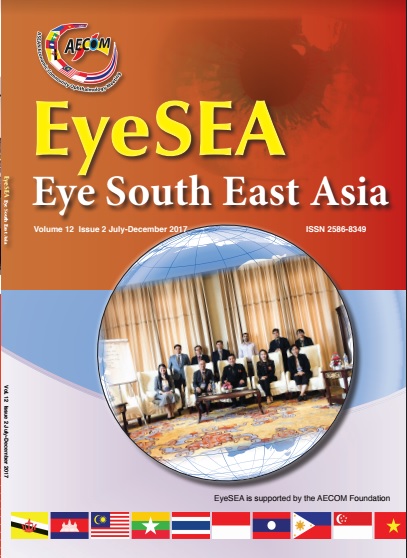CHARACTERISTICS AND PROGNOSTIC INDICATORS OF FINAL VISUAL ACUITY IN PEDIATRIC OPEN GLOBE INJURY
Main Article Content
Abstract
BACKGROUND: Pediatric open globe injury is a common disease which not only brings about severe visual impairment in children but also results in huge economic burden for the society.
PURPOSE: To evaluate the characteristics as well as prognostic factors associated with unfavorable postoperative visual acuity in pediatric open globe injury.
METHODS: This was a prospective non – comparative case series recruiting 93 children aged from 3 to 15, and were admitted to The Pediatric Department of Ho Chi Minh City Eye Hospital with open globe injuries from November of 2013 to April of 2014. Duration of follow up was 6 months since the last operation. All the epidemiological and clinical characteristics as well as treatment outcomes were assessed. The association between prognostic indicators and unfavorable final visual acuity (< 20/200) was determined via multivariable logistic regression analysis.
RESULTS: The mean age of the research population was 9.04 ± 3.05. Injuries occurred more commonly in boys than in girls (the male to female ratio was 2.20). There were 63.44% of patients injured at home. 80.44% of children got open globe injuries while playing. Sharp object made up the largest percentage of all causes (65.59%). Corneal laceration, accounted for 68.82%, was the commonest type of trauma. 71.95% of children had initial visual acuity less than 20/200. 82 children were followed up until 6 months postoperatively and 75.61% of them had final best-corrected visual acuity ≥ 20/200. Complications’ incidence was quite low (< 10%). Prognostic factors associated with poor final visual acuity were: centrally corneal-related injury, wound length ≥ 6mm, vitreous hemorrhage, endophthalmitis and retinal detachment.
CONCLUSION: Our study results can be beneficial for health educational programs of open globe injuries prevention in children. Unfavourable prognostic indicators are likely to help pediatric ophthalmologists predict their patients’ final visual acuity.
Article Details
References
Acar, U., et al., A new ocular trauma score in pediatric penetrating eye injuries. Eye (Lond), 2011. 25(3): p. 370-4.
Bui Thi Thanh Huong, et al., Surveilence of eye trauma in Ho Chi City Eye Hospital from 1999 to 2001. Medical Journal of University of Pharmacy and Medicine of Ho Chi Minh City, 2001.
Bunting, H., D. Stephens, and K. Mireskandari, Prediction of visual outcomes after open globe injury in children: a 17-year Canadian experience. J AAPOS, 2013. 17(1): p. 43-8.
Ferenc Kuhn, D.J.P., Ocular trauma: Principles and Practice. 2002. Thiem Medical Publishers, Inc.
InternationalCouncilofOphthalmology, Visual standards: Aspects and ranges of vision loss, 2002.
Jandeck, C., et al., Open globe injuries in children. Graefes Arch Clin Exp Ophthalmol, 2000. 238(5): p. 420-6.
Knyazer, B., et al., Prognostic factors in posterior open globe injuries (zone-III injuries). Clin Experiment Ophthalmol, 2008. 36(9): p. 836-41.
Kuhn, F., et al., A standardized classification of ocular trauma. Graefes Arch Clin Exp Ophthalmol, 1996. 234(6): p. 399-403.
Le Do Thuy Lan, et al., Results of treatment of anterior open globe injury in children. Medical Journal of University of Pharmacy and Medicine of Ho Chi Minh City, 2002.
Lee, C.-H., et al., Prognostic indicators of open globe injuries in children. The American Journal of Emergency Medicine, 2009. 27(5): p. 530-535.
Liu, X., et al., Determination of visual prognosis in children with open globe injuries. Eye, 2014. 28(7): p. 852-856.
Nash, E.A. and C.E. Margo, Patterns of emergency department visits for disorders of the eye and ocular adnexa. Arch Ophthalmol, 1998. 116(9): p. 1222-6.
Négrel, A.D. and B. Thylefors, The global impact of eye injuries. Ophthalmic Epidemiol, 1998. 5(3): p. 143-169.
Ojabo, C.O., K.N. Malu, and O.S. Adeniyi, Open globe injuries in nigerian children: epidemiological characteristics, etiological factors, and visual outcome. Middle East Afr J Ophthalmol, 2015. 22(1): p. 69-73.
Parver, L.M., et al., Characteristics and causes of penetrating eye injuries reported to the National Eye Trauma System Registry, 1985-91. Public Health Rep, 1993. 108(5): p. 625-32.
Rahman, I., et al., Open globe injuries: factors predictive of poor outcome. Eye (Lond), 2006. 20(12): p. 1336-41.
Rostomian, K., et al., Open globe injuries in children. J AAPOS, 1998. 2(4): p. 234-8.
Schorkhuber, M.M., et al., Ocular trauma scores in paediatric open globe injuries. Br J Ophthalmol, 2014. 98(5): p. 664-8.
Serrano, J.C., P. Chalela, and J.D. Arias, Epidemiology of childhood ocular trauma in a northeastern Colombian region. Arch Ophthalmol, 2003. 121(10): p. 1439-45.
Sternberg, P., Jr., E. de Juan, Jr., and R.G. Michels, Penetrating ocular injuries in young patients. Initial injuries and visual results. Retina, 1984. 4(1): p. 5-8.
Thylefors, B., Epidemiological patterns of ocular trauma. Aust N Z J Ophthalmol, 1992. 20(2): p. 95-8.
Tielsch, J.M. and L.M. Parver, Determinants of hospital charges and length of stay for ocular trauma. Ophthalmology, 1990. 97(2): p. 231-7.
Tok, O., et al., Epidemiological characteristics and visual outcome after open globe injuries in children. J AAPOS, 2011. 15(6): p. 556-61.
World Health Organization, Prevetion of childhood blindness. Causes of childhood blindness and current control measures 1992; 21-22, WHO, Geneva.


